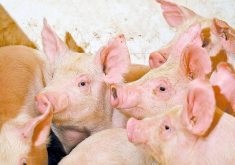Breeding targets can only be achieved when there is a ready supply of gilts available to replace sows that are culled or which die.
Bernie Peet is president of Pork Chain Consulting Ltd. of Lacombe, Alberta, and editor of Western Hog Journal.
In my last article, I looked at some of the factors that influence output (kilos of pork) from the finishing barn. The number of pigs weaned into the nursery each week is the major determinant of the number of market hogs sold. Therefore, achieving the required number of pigs weaned each and every week is fundamental to hitting output targets in a pork production business. The challenge is that the factors affecting breeding herd output are more likely to vary, which means that careful targeting and monitoring is essential.
Read Also

Horns aren’t unlocking anytime soon on livestock transport standards
Standards good enough meet the definition of “humane” animal transportation still vary widely between what what industry wants, what animal rights advocates want and, between the two, what federal regulators decide is good enough.
SETTING AND ADJUSTING TARGETS
Let’s assume that the output target is to market 500 pigs per week. There are six key measures that need to be monitored and controlled, which are shown below with some assumptions for efficiency factors that I will use for illustration:
Pigs weaned/week 524
Pre-wean mortality 10%
Pigs born alive/week 582
Av. # born alive/litter 11.2
Litters born/week 52
Farrowing rate 84%
Sows bred/week 62
The relative effect of each of these factors on numbers weaned varies considerably. The most important by far is the number of sows bred each week, followed by farrowing rate and number born alive per litter. These are also the numbers that tend to vary most from week to week, which means they are the most important to monitor and respond to. If one of the targets is missed or exceeded, the deviation must be quickly rectified or one of the other targets adjusted in order to compensate. Because the number of sows bred per week has the biggest influence, it is the easiest one to alter in order to achieve target output. In the example shown, if pre-wean mortality increased to 12 per cent, number of pigs weaned/week would fall by 12, to 512. Breeding two extra sows per week would result in over 16 more weaned pigs each week, which would more than compensate.
Changes in farrowing rate must be monitored and responded to. Because it takes four months before farrowing rate can be calculated, the percentage of sows that are tested positive when they are first scanned at four to five weeks can be used as a predictor of farrowing rate because pregnancy failures are low after that time. Farrowing rate also varies from week to week, so it is best to calculate an eight-week rolling average and respond when it deviates from target, adjusting the target for number of sows bred per week in order to achieve the required number of farrowings.
ACHIEVING CONSTANT OUTPUT
There are several important aspects of management that influence our ability to achieve constant output from the breeding herd.
Productive sow herd size: The number of “productive sows” is the number of sows and bred gilts in the herd and excludes unbred gilts. The number of pigs they are able to wean depends on their litter size and the number of litters they have each year. Therefore, if either of these two factors changes, the productive sow herd size must be adjusted accordingly. For example, 1,000 sows producing 2.4 litters per sow/year (LSY) will result in 1,000 X 2.4/52 litters per week, or 46. If the LSY falls to 2.3, then only 44 sows will farrow each week, resulting in lower numbers weaned. To compensate, the productive sow herd size would have to be increased to 1,040. This relationship makes productive sow herd size is a very important target to monitor and control.
Gilt pool size: Breeding targets can only be achieved when there is a ready supply of gilts available to replace sows that are culled or which die. A target figure for gilt intake into the breeding herd can be calculated from the expected sow replacement rate. The gilt pool size is then the number of gilts introduced expressed on a per-week basis multiplied by the average number of weeks from entry to service. Gilt pool size is a valuable measure of the ability of a herd to maintain breeding targets.
Culling policy: It is obvious that productive sow herd size will be reduced if more sows are culled than there are gilts to replace them. Consequently culling needs to take place with due regard to the target herd size. Sows should never be culled until weekly breeding targets have been met, unless it is done on health or welfare grounds. Ideally, all available sows should be bred and decisions taken on culling after first return date or at first scanning, with sows selectively culled based on performance history if there are more sows pregnant than required.
Herd parity profile: Many aspects of sow performance vary according to sow parity. Therefore the number of sows in each parity affects breeding herd output and a stable parity profile will result in reduced performance variation over time. Attention to maintaining the correct parity profile through good management of culling and replacement policy will make a big contribution towards achieving constant output. Constant weekly output can be only be achieved by recording and monitoring the key output targets. By regularly adjusting targets in response to changes in the actual figures, the number of pigs weaned each week can be closely controlled. However, this requires discipline and the application of consistent management standards to be successful.














